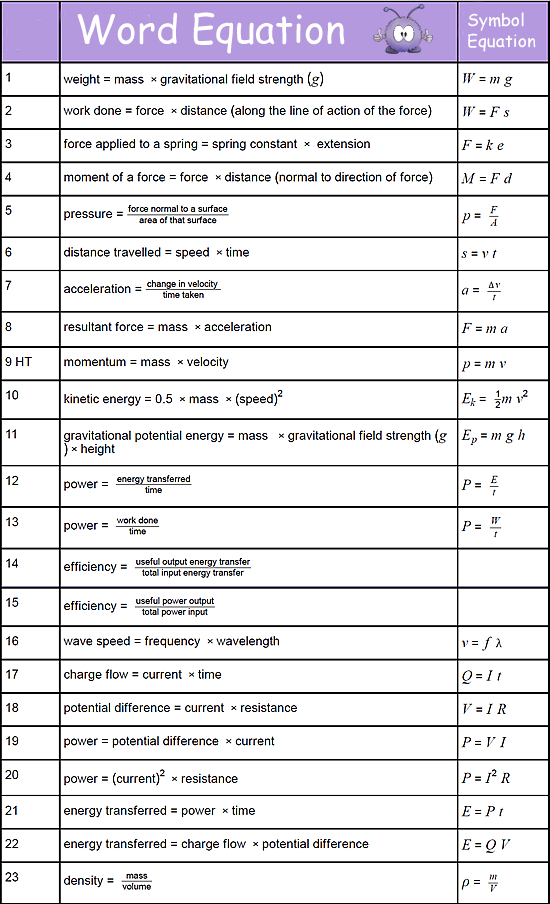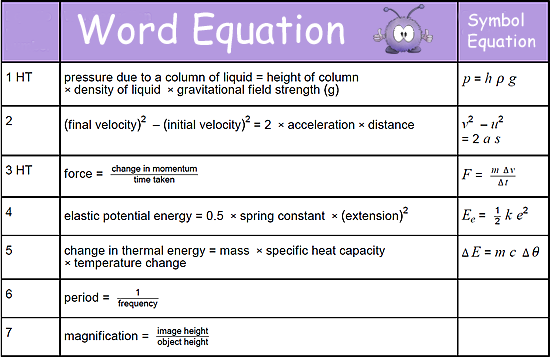AQA PHYSICS GCSE: 8463Interactive Syllabus
Do bother to take a look! There are lots of interesting pages.... and they might well improve your grade. Units you should know:In solving quantitative problems, students are expected to be able to recall and apply the following equations, using standard SI units. That means you have to learn them - they will not be given to you! Equations required for Higher Tier papers only are indicated by HT in the left hand column.
The following equations will be given to you on a data sheet - but you still need to know the abbreviation symbol/letter used for physical properties and the unit they need to be expressed in.
Content:4.1 Energy
4.2 Electricity
4.3 Particle model of matter
|
| 4.3.1 | Changes of state and the particle model |
| 4.3.1.1 | Density of materials |
| 4.3.1.2 | Changes of state |
| 4.3.2 | Internal energy and energy transfers |
| 4.3.2.1 | Internal energy |
| 4.3.2.2 | Temperature changes in a system and specific heat capacity |
| 4.3.2.3 | Changes of state and specific latent heat |
| 4.3.3 | Particle model and pressure |
| 4.3.3.1 | Particle motion in gases |
| 4.3.3.2 | Pressure in gases |
| 4.3.3.3 | Increasing the pressure of a gas (HT only) |
4.4 Atomic structure
| 4.4.1 | Atoms and isotopes |
| 4.4.1.1 | The structure of an atom |
| 4.4.1.2 | Mass number, atomic number and isotopes |
| 4.4.1.3 | The development of the model of the atom |
| 4.4.2 | Atoms and nuclear radiation |
| 4.4.2.1 | Radioactive decay and nuclear radiation |
| 4.4.2.2 | Nuclear equations |
| 4.4.2.3 | Half-lives and the random nature of radioactive decay |
| 4.4.2.4 | Radioactive contamination |
| 4.4.3 | Hazards and uses of radioactive emissions and of background radiation |
| 4.4.3.1 | Background radiation |
| 4.4.3.2 | Different half-lives of radioactive isotopes |
| 4.4.3.3 | Uses of nuclear radiation |
| 4.4.4 | Nuclear fission and fusion |
| 4.4.4.1 | Nuclear fission |
| 4.4.4.2 | Nuclear fusion |
4.5 Forces
| 4.5.1 | Forces and their interactions |
| 4.5.1.1 | Scalar and vector quantities |
| 4.5.1.2 | Contact and non-contact forces |
| 4.5.1.3 | Gravity |
| 4.5.1.4 | Resultant forces |
| 4.5.2 | Work done and energy transfer |
| 4.5.3 | Forces and elasticity |
| 4.5.4 | Moments, levers and gears |
| 4.5.5 | Pressure and pressure differences in fluids |
| 4.5.5.1 | Pressure in a fluid |
| 4.5.5.2 | Atmospheric pressure |
| 4.5.6 | Forces and motion |
| 4.5.6.1 | Describing motion along a line |
| 4.5.6.1.1 | Distance and displacement |
| 4.5.6.1.2 | Speed |
| 4.5.6.1.3 | Velocity |
| 4.5.6.1.4 | The distance–time relationship |
| 4.5.6.1.5 | Acceleration |
| 4.5.6.2 | Forces, accelerations and Newton's Laws of motion |
| 4.5.6.2.1 | Newton's First Law |
| 4.5.6.2.2 | Newton's Second Law |
| 4.5.6.2.3 | Newton's Third Law |
| 4.5.6.3 | Forces and braking |
| 4.5.6.3.1 | Stopping distance |
| 4.5.6.3.2 | Reaction time |
| 4.5.6.3.3 | Factors affecting braking distance |
| 4.5.7 | Momentum |
| 4.5.7.1 | Momentum is a property of moving objects |
| 4.5.7.2 | Conservation of momentum |
| 4.5.7.3 | Changes in momentum |
4.6 Waves
4.7 Magnetism and electromagnetism
| 4.7.1 | Permanent and induced magnetism, magnetic forces and fields |
| 4.7.1.1 | Poles of a magnet |
| 4.7.1.2 | Magnetic fields |
| 4.7.2 | The motor effect |
| 4.7.2.1 | Electromagnetism |
| 4.7.2.2 | Fleming's left-hand rule |
| 4.7.2.3 | Electric motors |
| 4.7.2.4 | Loudspeakers |
| 4.7.3 | Induced potential, transformers and the National Grid (physics only) (HT only) |
| 4.7.3.1 | Induced potential |
| 4.7.3.2 | Uses of the generator effect |
| 4.7.3.3 | Microphones |
| 4.7.3.4 | Transformers |
4.8 Space physics
| 4.8.1 | Solar system; stability of orbital motions; satellites |
| 4.8.1.1 | Our solar system |
| 4.8.1.2 | The life cycle of a star |
| 4.8.1.3 | Orbital motion, natural and artificial satellites |
| 4.8.2 | Redshift |
4.9 Key ideas
The complex and diverse phenomena of the natural and man-made world can be described in terms of a small number of key ideas in physics.
These key ideas are of universal application, and we have embedded them throughout the subject content. They underpin many aspects of the science assessment and will therefore be assessed across all papers. This means you should mention these key ideas in all of your answers wherever possible!
Key ideas in physics include:
![]() the use of models, as in the particle model of matter or the wave models of light and of sound
the use of models, as in the particle model of matter or the wave models of light and of sound
![]() the concept of cause and effect in explaining such links as those between force and acceleration, or between changes in atomic nuclei and radioactive emissions
the concept of cause and effect in explaining such links as those between force and acceleration, or between changes in atomic nuclei and radioactive emissions
![]() the phenomena of 'action at a distance' and the related concept of the field as the key to analysing electrical, magnetic and gravitational effects
the phenomena of 'action at a distance' and the related concept of the field as the key to analysing electrical, magnetic and gravitational effects
![]() that differences, for example between pressures or temperatures or electrical potentials, are the drivers of change
that differences, for example between pressures or temperatures or electrical potentials, are the drivers of change
![]() that proportionality, for example between weight and mass of an object or between force and extension in a spring, is an important aspect of many models in science
that proportionality, for example between weight and mass of an object or between force and extension in a spring, is an important aspect of many models in science
![]() that physical laws and models are expressed in mathematical form.
that physical laws and models are expressed in mathematical form.
Follow me...








